Blog one of three updating Achen Gangyab/Hoh Xil: problematic UNESCO World Heritage
IN LOVE WITH ICONIC TIBETAN SPECIES
Now that UNESCO has bestowed its prestigious World Heritage badging to a remote portion of the Tibetan Plateau, China is figuring out what to do with this jewel of alpine desert, even though very few lowland Han Chinese have seen it, maybe few ever will.
This is the remote upland summer pasture of Achen Gangyab, its Tibetan name, or in Mongolian Hoh Xil, the name China prefers. China sometimes calls it Aqing Gongjia 阿青公加, a pinyin garble of the Tibetan. It is way too far west to have ever had a Chinese name, other than a pinyinisation from the Mongolian: Kekexili 可可西里.
When China nominated Hoh Xil for UNESCO status, Rukor posted blogs analysing China’s proposal, and the failure of the IUCN team sent by UNESCO to verify it, to challenge China’s nonsensical claim that Hoh Xil is “no-man’s land”, empty of people. Now, over two years later, with Hoh Xil under the UNESCO umbrella, what’s new?
Two UN Special Rapporteurs in 2018 expressed their dismay at how China and UNESCO completely ignored the Tibetans of Hoh Xil, as if they don’t exist.
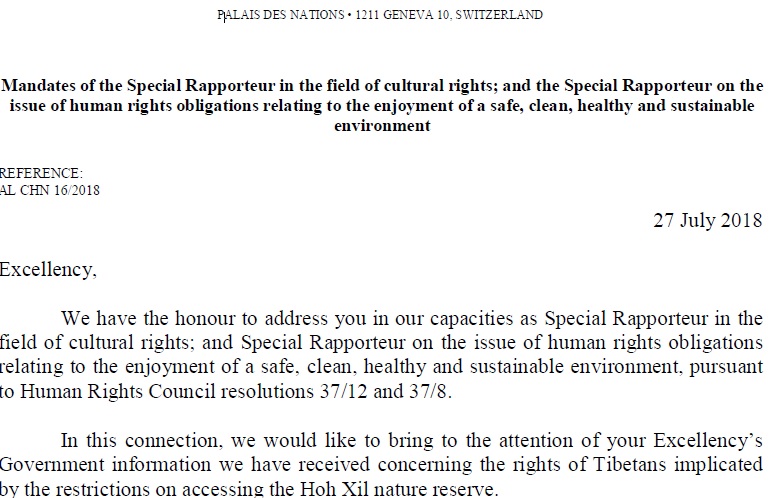
There is now a lot going on, and a new expressway runs through it. To celebrate Hoh Xil’s arrival in its new Chinese incarnation, the weekly newspaper Qinghai Scitech News has published a special eight-page supplement dedicated to Hoh Xil World Heritage. Eight tabloid pages are enough for many articles, some years old, as the editors hunted around for anything that fits their popular science remit. A close look at those articles tells us much about how China now argues with itself over what meanings to ascribe to the unfamiliar Hoh Xil landscape, as it debuts in China’s consciousness.
China in this new era of highly centralised messaging management usually seems to speak in only one voice. Yet this miscellany on Hoh Xil has many voices and viewpoints, which reveal the difficulties inbuilt to the attempt to manage pristine wilderness. So it’s worth a careful look.
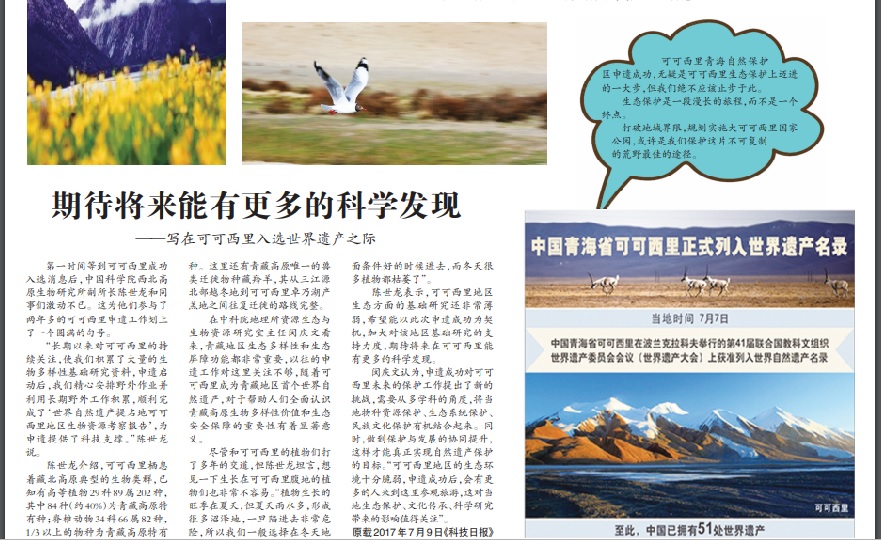
The overall tone is celebratory, lyrically evoking not only the beauty of this mostly frozen landscape, but insisting this has to be China’s greatest wilderness. The language is effusive: “From small animals such as pika, plateau rabbit, to ungulates such as Tibetan antelope, Tibetan gazelle, and Tibetan wild ass, to predators, donkeys, wolves, etc., the animals have obviously become the masters of the wilderness. This is Hoh Xil, China’s greatest wilderness! And what we have to do is to make the wilderness always wild!”
This rapturous language embodies several agendas. Above all, Hoh Xil is China’s. The sacred task ahead is to maintain nature in all its inherent wildness, a task other articles problematize as anything but straightforward. Agency and ownership are attributed to the animals, no mention of the Tibetan drogpa nomads who herd their yaks, sheep and goats to this pasture each summer, travelling peaceably alongside the iconic wild Tibetan antelopes (one of the 2008 Beijing Olympics mascots) and Tibetan gazelles.
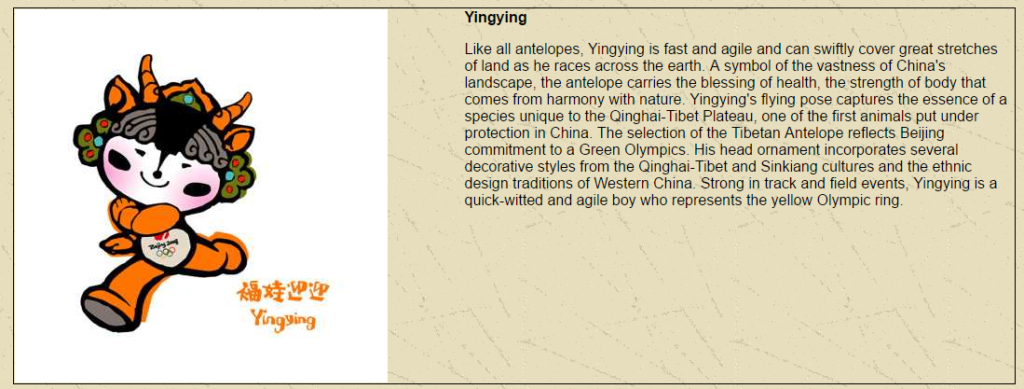
In this dominant telling, sharply contradicted by other articles, the animals have become the masters, a phrase familiar to anyone growing up in China, as the CCP insists its monopoly on power is proof the masses have become the masters. Hoh Xil belongs to the animals, or at least the iconic species that evoke human admiration. Past human use is amnesically erased, secure in the knowledge that the past is no longer present, as livestock production is now, under UNESCO World Heritage protection, banned.
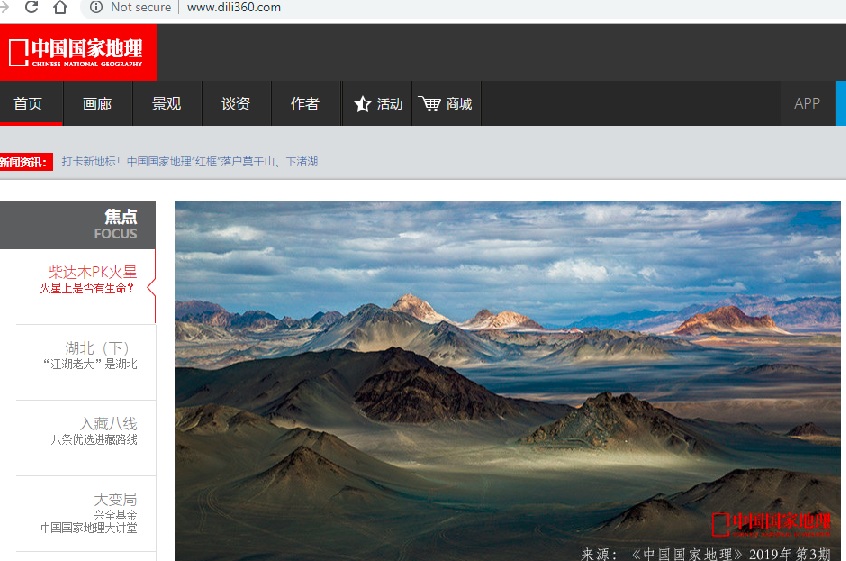
The enchantment has an operatic repetitiveness: “Because Hoh Xil has not only Tibetan antelopes, but also hundreds of birds and animals, and everything grows, it is the greatest wilderness in China. The groundwater is also heated, at an altitude of 5,000 meters, creating the highest temperature spa in the world. Under the strong desire of mankind to transform nature, the vast area is not enough to keep Hoh Xil in the wild, and it needs its own capabilities. The primary skill is cold. Permafrost covers more than 90% of the land. The thickness of the frozen soil is 80-120 meters. There are huge glaciers on the high mountains, and the ice tongues are pouring down for dozens of kilometres. Walking in it the tall ice bodies dwarf you, like facing an ice wall. The second skill/capability of Hoh Xil to maintain the wilderness is also the result of the lake. The snow and ice on the mountains continue to flow into the Hoh Xil Basin. The terrain in the basin is gentle and the drainage is not smooth. In addition, permafrost prevents the water from seeping into the ground, so it accumulates water into a lake. At the famous Sun Lake, in the evening, the golden light shines, the snow peaks stretch, and the lake is like a dream. More places outside the lake are swampy wetlands, and even with modern means of transportation, entering Hoh Xil is not an easy task. The third skill of Hoh Xil to maintain the wilderness is related to its location in the hinterland of the Qinghai-Tibet Plateau. Hoh Xil has not been eroded by the river on a large scale. Its terrain is gentle and undulating, with a relative altitude of only 300 to 600 meters. It is the most intact plateau platform on the roof of the world. Due to the three skills of Hoh Xil, there are few traces of artificial transformation.”
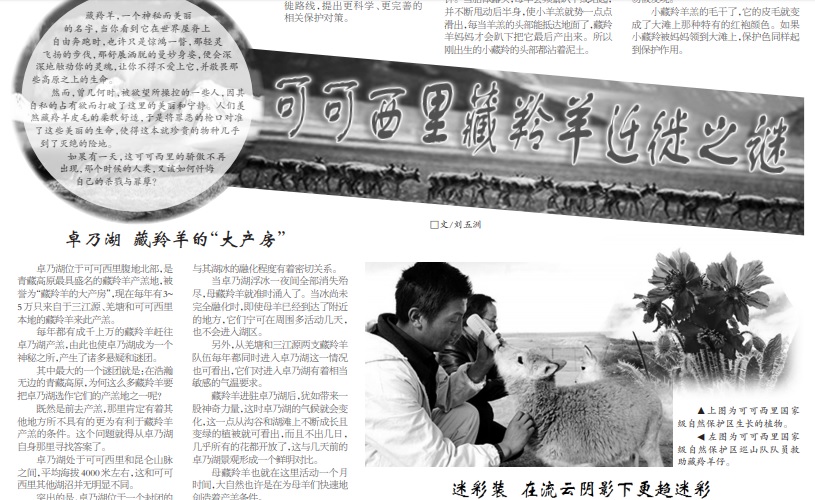
This passionate representation is so anthropocentric, it attributes agency, even mastery, not only to the iconic mammals but to the qualities of the landscape itself. Clearly the descriptions all originate from scientific quantification of temperature, permafrost depth etc., yet the discourse is one of rapturous nature worship.
Even in this transcendental embrace of eternal wildness, a note of anxiety emerges. “The strong desire of mankind to transform nature”, the danger of “artificial transformation” is always on the horizon. So the message is a double movement: let’s celebrate this wilderness, because it is China’s even if you’ve never before heard of it; but, please, celebrate it at a distance. A note of tension is introduced, a tension which in other articles takes centre stage.
Next up is an article abounding in contradictions, reprinted from the prestige full-colour China National Geographic, whose resemblance to National Geographic is no accident, both in layout and design, and in its hero worship of explorers able to penetrate the most dangerous wildernesses. On one hand, we are told in pictures and words: “This is the last virgin land on earth. This is the last piece of nature in our country that retains its original state and the largest unmanned area: Hoh Xil. Glaciers and frozen soils have created a vast expanse of wetlands, making the Qinghai-Tibet Plateau “China’s largest water tower”.
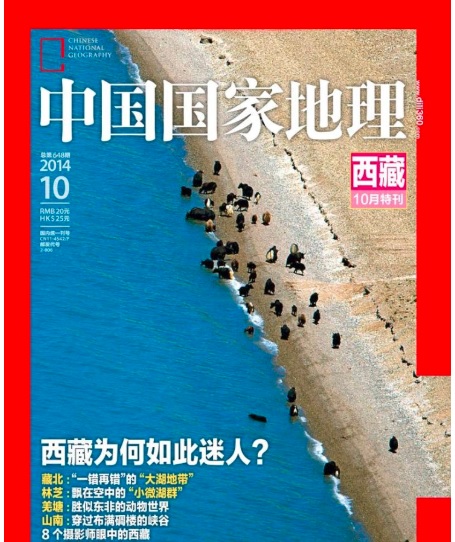
But there are also warnings: “Hoh Xil is the most desolate area on the Qinghai-Tibet Plateau. It is the “best of the plateau” and is extremely dangerous. The vast terrain is high, about 5,000 meters or higher, the air is thin, the climate is extremely cold, and the natural environment is extremely harsh. It is difficult for people to enter, only in the east and west. In the summer, there are individual herders grazing activities, and the vast areas are uninhabited areas.” The editor-in-chief of China National Geographic, Shan Zhijun, has entered the Hoh Xil with the expedition team. Hoh Xil is not an absolute no man’s land. Shan Zhijun pointed out: ‘Not to mention the gold digger who has lived in Hoh Xil for many years, the people who have been fishing for Artemisia, and there have been pastoralists grazing from the past to the present. Ancient archaeological sites are still in Wulanwula [Ulan Ula] Lake and Isuma River. I found evidence that early humans lived there.’”
This is deeply ambivalent about the human presence, unless it is tens of thousands of years ago, leaving only archaeological traces. Although ”original” and “unmanned”, Hoh Xil is also “not an absolute no man’s land” even though China’s UNESCO nomination dossier repeatedly defines it as no-man’s land, and UNESCO’s IUCN team sent to the area to test China’s claims never spoke to a single nomad.
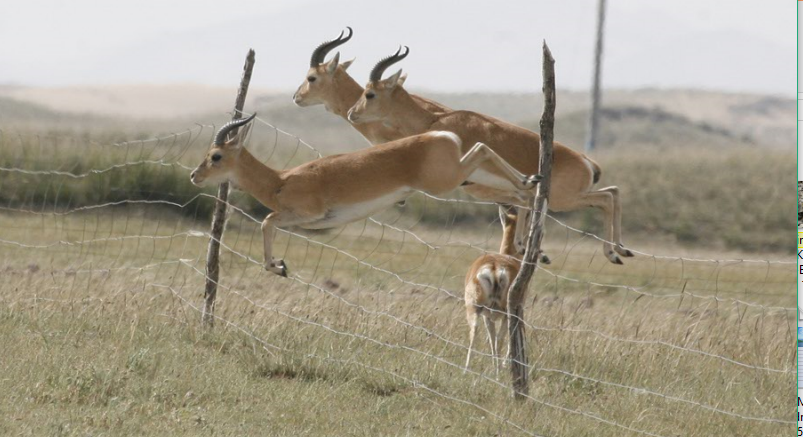
Having acknowledged a human presence shaping the virgin land, it turns out to be motley bunch: gatherers of Artemisia plants much used in sowa rigpa traditional Tibetan medicine; pastoralists past and present, with their livestock herds; and nefarious gold diggers resident in Hoh Xil “for many years.”
What are we to make of this jumble of contradictions?
All is explained, in an article reprinted from a 2009 exposé, of facts carefully concealed from UNESCO and IUCN. The villains are explicitly Hui, Chinese Muslims now classified as a minority ethnicity, whose mother tongue is standard Chinese, having no mother tongue of their own; in other words, Han Chinese who happen to be Muslim. They featured strongly in the 2004 movie Kekexili: Mountain Patrol, as murderous and rapacious.
We are now reminded: “An article in “An Anthropology Case Study of Hui Rural Residents” describes the past of Shangtung Village. It is said that there are two kinds of people, the poorest and the richest, who have participated in the gold rush before liberation. Large wealthy households hired “Shawa” to enter mining areas such as Qumalai and Dachang for gold mining. Many years of gold rushing have allowed the shallow sands of the earth to be washed away, and mechanical power has become a tool of the new gold rush era. Mechanical operations have expanded the scale of gold rushing, changed interpersonal relationships, and formed a complex chain of interests. “Investigation” wrote: “The gold rushing activities originally relied mainly on family members need to supplement more non-family members to participate. Borrowing loans for expanding capital. Only those large families with large populations and good economic conditions can raise a large amount of money, and divide the contracted gold field into small pieces and contract them to other people in the village’ Shangzhao Village is not an isolated “island” of four gold rushes. It exists in a region of secret or semi-public gold trading chain. In the Haidong area of Qinghai, in the farmland of Yuzhong County, Datong County, and Minhe County, the men in the village went to the gold rush as a sideline, which is a kind of “tradition”.At the department store at the intersection of Suizhong County, there is a small counter for collecting gold sand. It is co-located with the glass counters of the latest mobile phones, as part of everyday life. Haidong men, every year when the frozen soil of the Qinghai-Tibet Plateau melts, follow the gold-rushing boss to enter the barren hills and mountains, doing what seem to be “no cost to buy and sell.” As for whether to come back, each is resigned. These gold-rushing bosses have both locals and “cross-river dragons” from Sichuan, Hubei. The most powerful boss will carry a large number of stalls with a large fleet of people, horses and guns.”
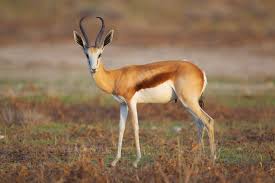
This is systematic plunder, by men from the easternmost counties of Qinghai, where Hui Muslim populations are concentrated, having displaced Tibetans from the lowlands, by force, a century ago. It began “before liberation” and flourishes in the era of mobile phones. This ethnographic account makes it clear that the gangs have their “dragon heads”, criminals higher up the hierarchy, to whom they sell their black market gold in far Sichuan and Hubei. This is highly organised crime; we are suddenly far from virgin wilderness.
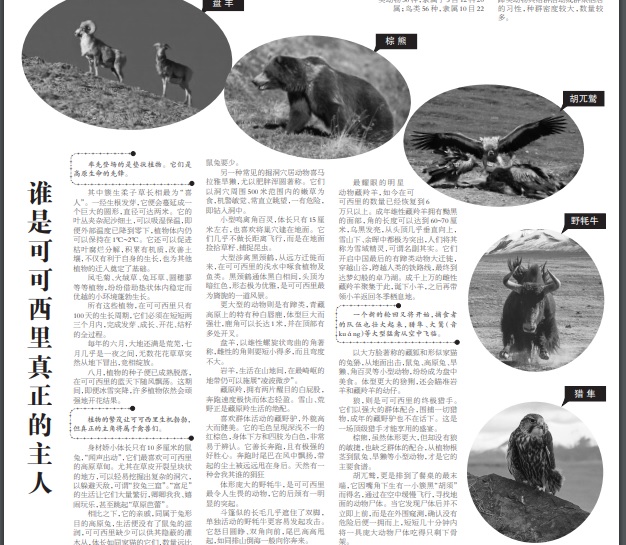
Yet in the next article, the biggest feature in this Hoh Xil miscellany, we are back in virgin wilderness, with not even a hint of any messy, complex, human past or present Hoh Xil. Who are the owners of Hoh Xil? 谁是可可西里真正的主人 This is the headline, answered immediately by thumbnails of the most iconic mammals of Hoh Xil. The Han embrace of the wondrous fauna of Hoh Xil is consummated; a union of man and beast, a triumphal celebration of what is solely China’s. Any human backstory in Achen Gangyab/Hoh Xil is erased.
China’s Communist Party instructed the masses that the revolution means that in a people’s republic, the people are now the owners. The gazelles, antelopes, argali big horned wild sheep, brown bears, wild yaks, vultures and eagles are the owners. All trace of a human past vanishes. Each photo is of an animal rampant, erect, proud, the yak charging at the camera.
Since almost no-one in distant lowland China had ever heard of Hoh Xil until very recently, this is an introduction, hence the need for a praise singer to extol the masculine virtues of the true owners of China’s back of beyond. The unique Han gaze salutes the unique fauna of China’s Hoh Xil. In British India, the Raj did the same, saluting the tigers and elephants.
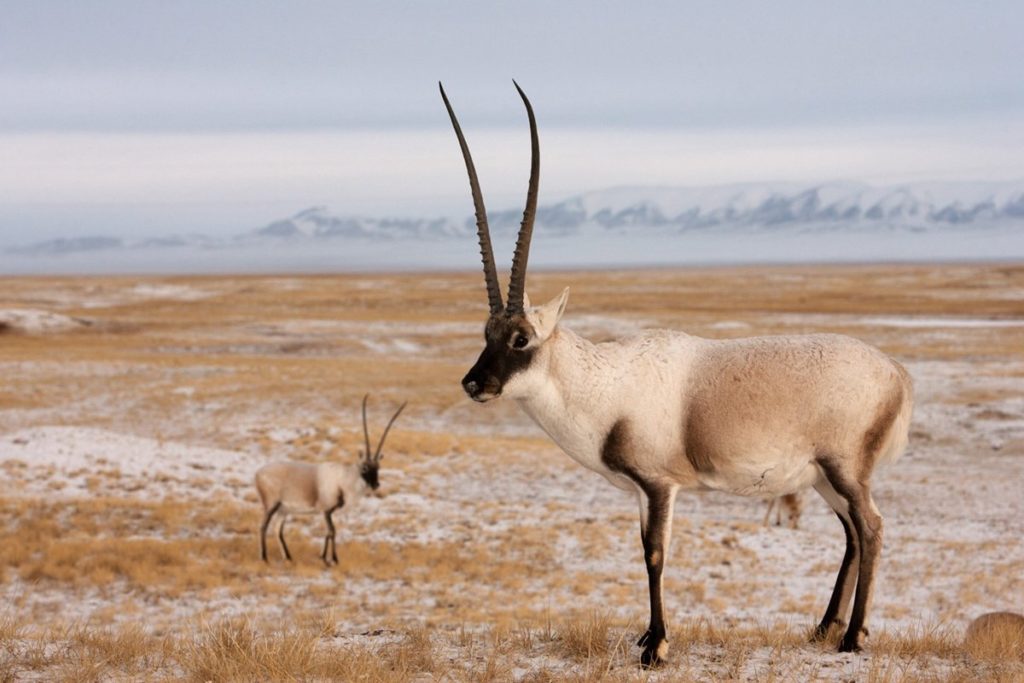
Since the few Han who do actually venture into Hoh Xil are scientists, and China’s nomination of Hoh Xil as World Heritage was done entirely, even exhaustively, in the name of science, it is wildlife science that frames this salute. Each species is defined scientifically, even when the biologists know little about them.
What is known makes for musical prose: “In July, almost overnight, countless flowers and plants suddenly emerge from the ground and compete. In August, the seeds of the plant have matured and fall in the wind of the blue sky of Hoh Xil. During this period, even though ice and snow suddenly fall, many plants will still bear fruit stubbornly. The luxuriance of plants makes Hoh Xil lively, but the real protagonist will belong to the beasts. Larger animals are hoofed, and the unique species of white-lipped deer on the Tibetan Plateau is huge and strong. The antlers can be as long as one metre and have multiple splits at the top. Argali sheep, known for the male spiral curved horns, the female’s angle is much shorter, and the curvature is not large. Tibetan gazelle, with two striking white buttocks, runs extremely fast and is light. Snow mountains and wilderness are the perfect match for Tibetan gazelle life. Tibetan wild ass like herd activities, tall and healthy. Its coat colour is shades of reddish brown, white under the body and limbs, very recognizable. It runs very well and has a strong heart. When running, the tail fluttered in the wind, and the dust brought up was far behind. The most dazzling star animal, the Tibetan antelope, has now recovered to more than 60,000 in Hoh Xil. The adult male Tibetan antelope has a dark face. The length of the horn can reach 60~70 cm. The black hair is bright. It is almost vertical from the top of the head. It is very prominent under the snow mountain and the afterglow. People call it the snowy elf, which is worthy of the name. They opened the last migration of ungulates in China, crossing the valley, crossing the human railway line, and finally reaching the dreamy Lake of Donna. Thousands of female Tibetan antelopes gather here, giving births, and then leading the calves back to the winter habitat.”
What are we to make of this earthly paradise, and why does a new expressway run through it? Please try blog two in this series.